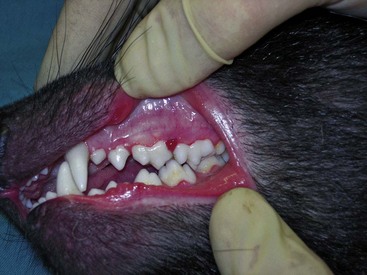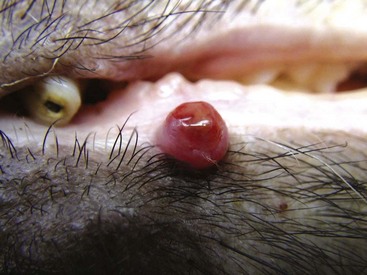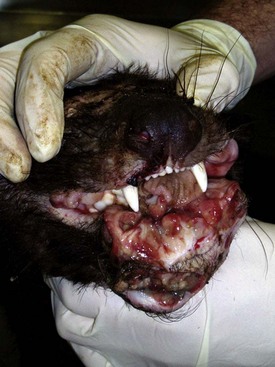Chapter 50 Tasmanian Devil Facial Tumor Disease
Tasmanian devil facial tumor disease (DFTD) was first recognized in Tasmanian devils (Sarcophilus harrisii) in northeastern Tasmania in 1996. Its origin remains unknown, but it appears to be a newly emerging disease because no devils trapped between 1964 and 1995 showed any evidence of DFTD.2
Signs and Symptoms
Affected devils develop tumors that present as large, solid, soft tissue masses that ulcerate, first appearing on the head and/or neck regions. Histologically, they form subepithelial expansile masses of round to spindloid cells with abundant eosinophilic cytoplasm encased within a pseudocapsule. Mitotic figures range from 0 to 12 and average 4/high-power field. The tumor is locally aggressive and metastasizes in 65% of cases, 57% of these to the local lymph nodes. Tumors similar to those on the face may occur later in other parts of the body.6 Devils younger than 2 years are rarely affected, with males and females being equally represented. Once clinical, the course of DFTD is rapid, with tumors enlarging from small nodules to large friable masses over the course of 2 to 3 months, and death usually occurs within 6 months.8 Mortality is 100%, mostly because of starvation, because the tumor destroys facial bones and dental arcades. In areas that have been affected for a long time, mature adults are scarce, with most animals being 2 years of age and younger. There is no treatment.
Diagnosis
Early lesions need to be diagnosed histologically because devils commonly develop neoplasms, which could be confused with DFTD grossly (Figs. 50-1 and 50-2). Once the condition is advanced, the gross appearance alone is diagnostic (Fig. 50-3).

Figure 50-1 Small mass on the gingiva of a Tasmanian devil. Histologic examination identified the mass as a hemangioma.

Figure 50-2 Small mass on the lip of a Tasmanian devil. Histologic examination identified the mass as DFTD.
Cause
Initially, a viral cause was suspected, but transmission electron microscopic examination of tumor cells did not find a virus. Research based on immunohistochemical stains have indicated that the tumor appears to be an undifferentiated sarcoma of possible neuroendocrine origin.7 However, a more recent study has shown that DFTD is a peripheral nerve sheath tumor that arose from a Schwann cell or Schwann cell precursor, because all tumors produce the Schwann cell–specific myelin protein, periaxin.10
Direct exposure to tumor cells is necessary for the development of DFTD but that alone is not sufficient for disease to occur. Damage to the skin or mucous membranes around the head and neck, as occurs with fighting, scratching, and biting, is also required before DFTD may develop. Most biting injuries occur between adult males and females during the 6-week mating season (February to March).3,4 It is noteworthy that lesions are rarely observed on other parts of the body that are also subject to trauma. Aerosol transmission and vertical transmission both appear unlikely. Transmission via fomites on carcasses or by cannibalism of diseased devils has not been discounted.4
The incubation period is unknown but one animal developed DFTD after 10 months in captivity without apparent exposure to tumor cells during that time.8
Tasmanian devils have 14 chromosomes. However, the tumors only have 13 chromosomes, lacking both sex chromosomes, both chromosomes 2, and one chromosome 6. All tumors studied have the same chromosomal anomalies, indicating their origin as clones from a rogue cell line that are transferred between individuals as allografts.11 Being different from the host cells, the tumor cells should be recognized as foreign and rejected. However, this is not the case, with lymphocyte infiltration into DFTD tumors rarely observed. Research has shown that devils do have a competent immune system, similar to that of other mammals.13 However, they have low genetic diversity, particularly at the major histocompatibility complex (MHC) locus. Therefore, tumor cells are not recognized as being foreign, so no immune response is mounted against them.12 Given the genetic similarity of tumors, it is not surprising that no cases have been seen in any other species.
Stay updated, free articles. Join our Telegram channel

Full access? Get Clinical Tree



